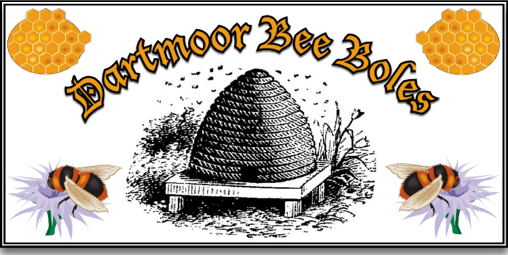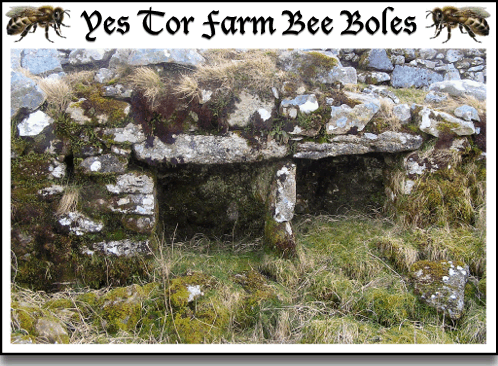
To this day if you look carefully around some of the old Dartmoor farms you will see what look like small cupboards made of granite. They are either built into or alongside a wall and will consist of anything from one to eight small recesses or niches, each with a granite lintel. These are in fact bee boles and it was in or on (depending on the type) them that the farmers would keep the straw bee hives or skeps. Today the majority of the boles are located on PRIVATE PROPERTY and the owner’s permission MUST be gained before visiting any of them.
There were two sorts of boles, those located outside for spring/summer use and those inside which were used in wintertime. The outside ones were ideally located in a south facing wall which would ensure plenty of morning sunlight, however there seems to be a great diversity of facing directions on Dartmoor. The inside niche boles would be fashioned into the internal walls of barns or outbuildings for use in the winter. Obviously these would protect the bee colonies from the worst of the cold weather, thus ensuring their survival until the following spring. Near Okehampton is a farm that has a barn with a stepped gable that houses three boles for winter use and this is estimated to date from 1750. There was no standard size for a bee bole but many were around about 18” x 18″ x 15″ deep, although there is considerable variation from farm to farm. Some of the skeps would stand on a flat stone slab that had a projecting lip, this provided a landing place for the bees.

The oldest examples of bee boles were at Buckfast Abbey although those that stand there today are a modern reconstruction built in 1995. It is thought that the originals dated back to medieval times. The table below lists the known bee boles on Dartmoor, their Ordnance Survey grid coordinates, how many boles are present, the date they were built, and which direction they face:
Records of bee boles and other beekeeping structures built in the past. Started by Dr Eva Crane in 1952, the Register now contains paper records for 1466 sites, and photographic prints, transparencies and/or electronic images for most of them. To improve accessibility to the
| Location | OS Grid Ref. | No. boles | Date | Facing |
| Bagtor House | 76555 75208 | 5 external | 1600s | SW |
| Batworthy Mill | 71448 85263 | 8 external | 1800s | SE |
| Beetor Farm | 71100 84443 | 3 external | 1700s | SE |
| Beetor Farm | 71100 84443 | 2 internal | ?? | n/a |
| Brook Farm | ||||
| Brownberry | 64860 74200 | 2 external | ?? | ? |
| Buckfast Abbey | 74143 67370 | 3 external (not original) | 1100s | E |
| Ford Farm | 73225 81148 | 4 external | 1700s | S |
| Heathercombe | 71840 81071 | 6 external | 1500s | E |
| Higher Westacott | 78930 86986 | 7 external | ?? | SW |
| Higher Westacott | 78930 86986 | 6 external | ?? | NW |
| Higher Westacott | 78930 86986 | 2 external | ?? | W |
| Marlborough House | 69??? 60??? | 6 external | 1500s | SE |
| Mill House, No. 2 | 65210 93542 | 4 external | 1400s | SE |
| Weeke Barton | 82090 88026 | 2 external | 1600s | SE |
| Yes Tor Farm | 56330 72796 | 2 external | ?? | SW |
The International Bee Research Association hold a register of the bee boles and other beekeeping structures that now holds 1,466 records for various sites across the country, the homepage for their website can be found – HERE
Reference.
Brain, P. & R. 1986 Disappearing Devon, Roundabout Devon Books, Instow.
Woods, S. H. 1988 Dartmoor Stone, Devon Books, Exeter.
 Legendary Dartmoor The many aspects past and present of Dartmoor
Legendary Dartmoor The many aspects past and present of Dartmoor
